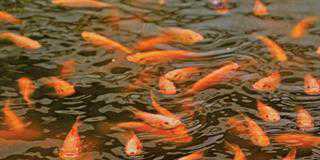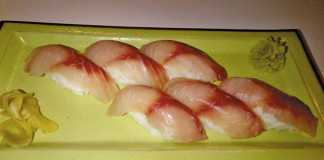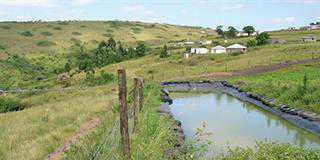For seven years Vaughn Bursey and John Tinley (above) of Smiling Valley Aquaculture have pursued and persevered their passion for aquaculture by farming marron freshwater crayfish. Mike Burgess visits them to find that this year – thanks to the knowledge gleaned from years of trial and error – they expect to produce up to 80 000 juveniles and 1 500kg edible marron from their 1,2ha of ponds.
On the slopes above a large dam on Vaughn Bursey’s stock farm in Kei Road, Eastern Cape, an array of ponds – covered by bird netting – are home to marron (Cherax tenuimanus) freshwater crayfish. Intially the ponds had been used for koi fish production but John Tinley and Vaughn Bursey have converted them to accommodate marron. Marron are produced commercially in the southwest and southeast of Australia and form an important industry there, but in South Africa the industry is still in its infancy. A ccording to John, Australian and African farmers are unwilling to part with their knowledge. “I travelled to Australia and seven out of the eight marron farmers refused me to visit them when they heard I was South African,” John says.
He eventually got a job rebuilding a run-down marron farm in exchange for food and accommodation. Attempts at sourcing information in SA also proved virtually impossible. Forced therefore to start farming marron using bits of knowledge – gleaned from John’s experience in Australia, the internet, literature and a few farmers in the Cape – John and began their operation tentatively and now seven years later admit it was a “struggle and a battle”.
After suffering crushing disasters – from false sellers to mass deaths of marron at certain ages – they learned on a trial and error basis how to farm marron and only recently managed to reverse their fortunes. This year they expect an impressive yield of 60 000 to 80 000 juveniles from their 1,2ha of ponds.
Major challenges
“To produce marron you need water,” John says, pointing to the large dam below his 20m x 25m stocking and breeding ponds. The ponds – oxygenated by paddlewheel aerators – are topped up with water when necessary, specifically during their partial drainage once every two to three weeks.
This is done to remove sediments and poor-quality water from the lower centre of the pool where marron don’t congregate. To successfully contain the marron, all drained water enters a special drainage pond stocked with black bass that hunt marron that might enter it.
Furthermore by law, all ponds must have walls of at least 500mm high built around them to stop marron from crawling out. Vaughn and John also cover the entire production area with bird netting to keep cormorants and herons out.
Marron has the potential to become a serious invader of fresh water systems in Southern Africa and for this reason strict precautions to prevent them escaping are crucial. All marron farming and possession are controlled by a permit system in terms of nature conservation legislation.
After an on-site inspection of the production facilities by the Department of Environmental Affairs and Tourism to ensure that facilities are not built in catchment areas and are safe from possible flooding, permits to farm with marron are issued. “It’s not easy to get on your feet,” Vaughn says, with their initial input (including initial breeding stock) costing R300 000.
He insists it could cost significantly less, and would take as little as six weeks with the knowledge he has today. Breeding marron successfully
“Breeding marron is very challenging,” John says. “Marron mate in early spring, incubating on average 300 eggs released as juveniles in early summer.” By late winter breeding stock should be placed in breeding ponds with one male to three to five females.
Water conditions, stock quality, predation, cannibalism and feeding techniques are major challenges to producing marron successfully, explains Vaughn. For example, water must be above 6ºC and below 30ºC (optimal temperature around 24ºC), while Ph levels should range between 7 and 8,5, and dissolved oxygen levels should be maintained at above 6ppm (parts per million).
The quality of breeding stock can mean the difference between success and failure. “Our first breeding stock was mature marron – a mistake as we now believe that marron that are adapted to particular conditions should not be moved, but that juveniles should rather be acquired as they can adapt to new conditions before breeding,” Vaughn says.
Despite losing up to 90% of their breeding adults, they managed to breed a couple of hundred juveniles. Predation of juveniles can, however, be a major problem with the main culprits being frogs, specifically the platanna, a vicious brown frog. “I once killed a plattie with 40 marron juveniles in its gut,” John says. “But they can be managed with specially designed electric fences.” Juveniles also need protection from cannibalistic neighbours by removing females with eggs from males, and females from the breeding ponds once all juveniles have been released.
Correct feeding techniques ensure efficient production and particular care should be taken not to overfeed – a situation that leads to a build-up of ammonia in the water, which eventually becomes toxic. “We feed a lot less here because of the nutrient-rich water,” John says. Feeding is not expensive when the marron’s feed conversion of between 80% to 90% is taken into account, explains Vaughn. John says sourcing feed and vitamins had been a major problem. “We are now producing our own feed as we couldn’t get quality feed on a regular basis in SA,”
John says. Marron are renowned for their disease resistance and in this regard Smiling Valley Aquaculture has not had any problems to date, even though marron are susceptible to certain diseases depending on were they are produced.
Ideas for the future
“We have not made money from marron because we only recently started breeding them successfully,” John says. “It was a case of not being able to supply what you don’t have.” However, by improving and even replacing particular production systems, John and Vaughn have over the last two years been able to reverse their fortunes. In 2005 they managed to produce over 4 000 juveniles and in 2006, thanks to critical changes in their production system, 21 000 juveniles were netted from one pond alone – all bigger and better than anything produced in previous years. “We are certain that we can produce marron successfully now,” Vaughn says. “We even have the opportunity to select marron with particular colour variations and of course the biggest for future breeding stock.”
Despite plans to supply certain outlets in East London, a major stumbling block to their success is ironically their isolated enthusiasm as they cannot produce the bulk needed to ensure continual local and possible international supply. Vaughn explains that the market for marron is growing but that the industry needs to grow regionally. John agrees,
“We are willing to use our knowledge and resources (breeding stock) to ensure this happens.” He hopes more people will become involved in marron production to fuel better organisation and possibly create a cooperative that can clean, process and market marron in large volumes. E-mail John Tinley and Vaughn Bursey at [email protected]. |fw
History of marron farming
Marron are the largest freshwater crayfish in the world – native to the main perennial rivers in the high rainfall areas in southwest Australia. This form of aquaculture was pioneered by Dr Noel Morrissy in the mid-1970s in Australia.
Marron reach weights of 60g to 100g within 12 months and between 100g to 300g in 24 months with an average tail recovery of 43%. They can be transported live in cool and moist air and can survive out of water for days. An international demand, specifically in Asia and Europe, exists due to their large size and high-quality flesh.
This is particularly true for the European markets, as native stocks have been devastated by crayfish plague fungus (Aphanomyces astaci). Of the few diseases, ailments and pests associated with marron, Thelohania – a protozoan that causes cotton tail or porcelain disease – and microsporidiosis caused by a pleistophorid, are the most serious after crayfish plague fungus.
Western Australia is home to the only disease-free stocks of marron in the world. Source: Marron by Graig Lawrence, Research Scientist (Aquaculture) Fisheries Department of Western Australia available at www.wa.gov.au.













